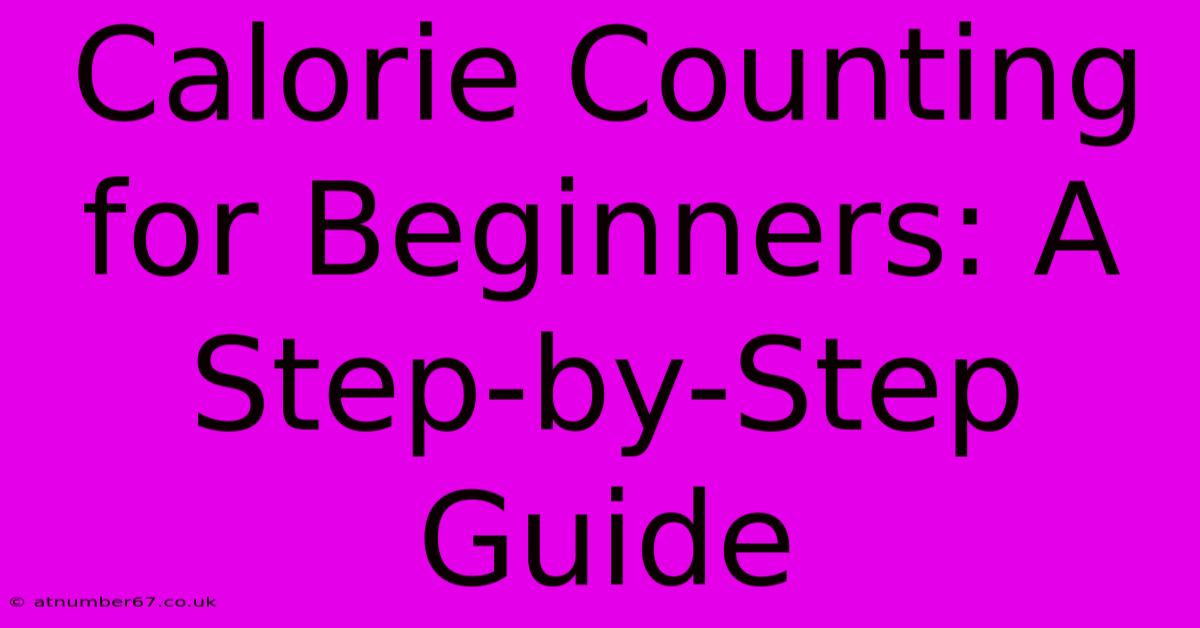Calorie Counting For Beginners: A Step-by-Step Guide

Table of Contents
Calorie Counting for Beginners: A Step-by-Step Guide
Losing weight or maintaining a healthy weight often involves understanding your calorie intake. Calorie counting, while it might sound daunting, is a valuable tool for achieving your fitness goals. This beginner's guide will walk you through the process step-by-step, making it manageable and effective.
Understanding Calories and Their Role in Weight Management
Before diving into the mechanics of calorie counting, let's clarify the basics. A calorie is a unit of energy found in food and drinks. Your body uses these calories to function, perform activities, and maintain its bodily processes. A calorie deficit (consuming fewer calories than your body burns) leads to weight loss, while a calorie surplus (consuming more calories than you burn) leads to weight gain. Maintaining your weight involves balancing calorie intake and expenditure.
What is a Calorie Deficit?
A calorie deficit is simply consuming fewer calories than your body needs to maintain its current weight. This forces your body to use stored fat for energy, resulting in weight loss. It's important to create a healthy deficit – too drastic a reduction can be harmful. Aim for a gradual and sustainable deficit rather than a rapid, unsustainable one.
What is a Calorie Surplus?
A calorie surplus, on the other hand, occurs when you consume more calories than your body needs. This excess energy is stored as fat, leading to weight gain. While a surplus can be beneficial for building muscle mass (when combined with strength training), it's crucial to manage it carefully to avoid excessive weight gain.
Step-by-Step Guide to Calorie Counting
1. Determine Your Basal Metabolic Rate (BMR): Your BMR represents the number of calories your body burns at rest. Several online calculators can estimate your BMR based on your age, gender, weight, and height. These are just estimations; individual metabolic rates vary.
2. Calculate Your Total Daily Energy Expenditure (TDEE): Your TDEE considers your BMR and your activity level. Multiply your BMR by an activity multiplier (sedentary = 1.2, lightly active = 1.375, moderately active = 1.55, very active = 1.725, extra active = 1.9). This provides a more accurate estimate of your daily calorie needs.
3. Choose Your Calorie Target: To lose weight, aim for a modest calorie deficit of 500-750 calories per day. This generally translates to about 1-1.5 pounds of weight loss per week. For weight maintenance, aim to consume your TDEE. For weight gain, consume a slight surplus (consult a nutritionist or doctor for personalized recommendations).
4. Track Your Calorie Intake: This is where the "counting" comes in! There are several methods:
- Food Scale: Weighing your food provides the most accurate calorie count.
- Calorie Counting Apps: Apps like MyFitnessPal, Lose It!, and Cronometer offer vast food databases and simplify tracking. These apps often have barcode scanners for easy entry.
- Food Journals: Manually recording your meals can be effective, but it's more time-consuming.
5. Be Consistent and Patient: Accuracy is key. Make sure you consistently track your food and drinks throughout the day. Remember, it's a journey, not a race. Weight loss takes time.
Tips for Successful Calorie Counting
- Don't Skip Meals: This can lead to overeating later in the day.
- Focus on Whole Foods: Prioritize fruits, vegetables, lean proteins, and whole grains. They provide more nutrients per calorie.
- Hydrate Regularly: Water helps you feel full and can prevent overeating.
- Listen to Your Body: Pay attention to your hunger and fullness cues.
- Consult a Professional: Registered dietitians or certified personal trainers can provide personalized guidance.
Potential Challenges and How to Overcome Them
- Underestimating Portions: Use a food scale for accurate measurements.
- Inaccurate Calorie Information: Use reliable sources and apps with frequently updated databases.
- Social Situations: Plan ahead and make healthy choices when eating out.
- Lack of Motivation: Find an accountability partner or join a support group.
Calorie counting is a powerful tool, but it's not a magic solution. Combine it with regular exercise and a balanced diet for optimal results. Remember consistency and patience are key to success! This detailed guide helps you to effectively and accurately track your calorie intake. Good luck on your journey to a healthier lifestyle!

Thank you for visiting our website wich cover about Calorie Counting For Beginners: A Step-by-Step Guide. We hope the information provided has been useful to you. Feel free to contact us if you have any questions or need further assistance. See you next time and dont miss to bookmark.
Featured Posts
-
Andre Ellis His Life His Truth
Mar 29, 2025
-
Marioo My Daughter A Fathers Unconditional Love
Mar 29, 2025
-
Ice Age Characters Lessons In Resilience
Mar 29, 2025
-
The Son In Law Who Wouldnt Be Broken
Mar 29, 2025
-
Halle Baileys Son The Sweetest Moments
Mar 29, 2025
